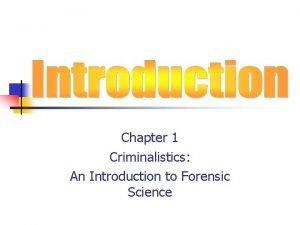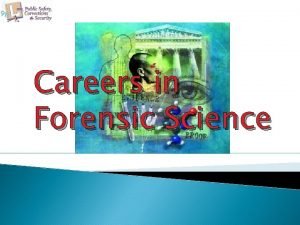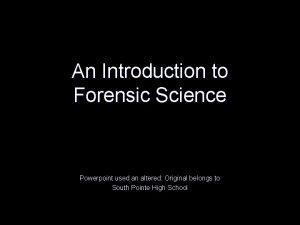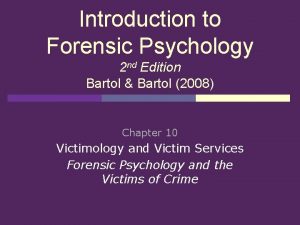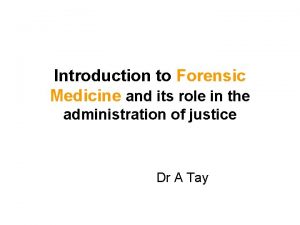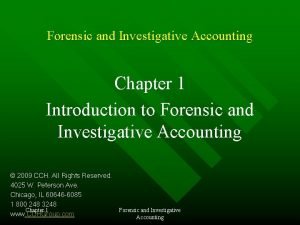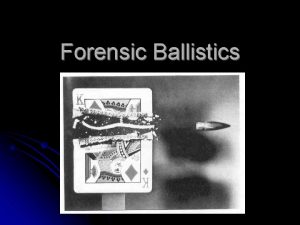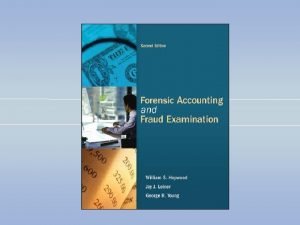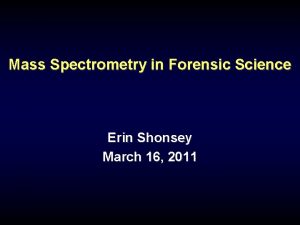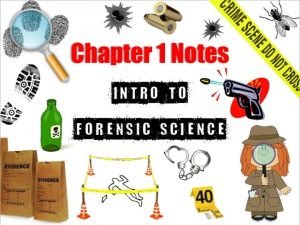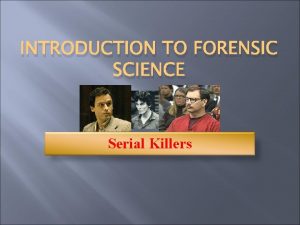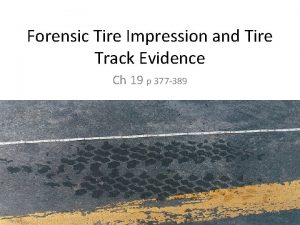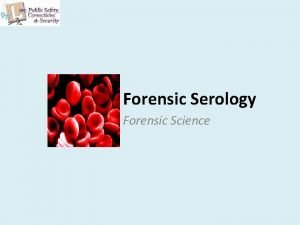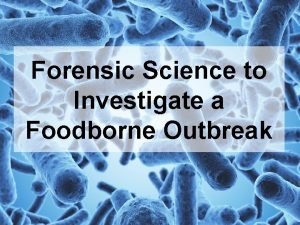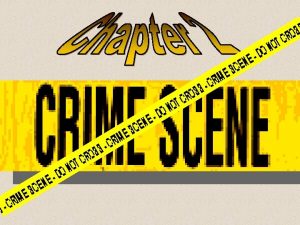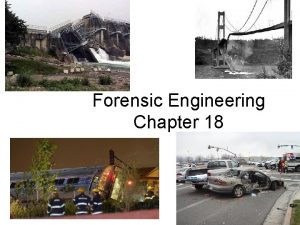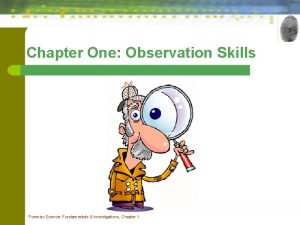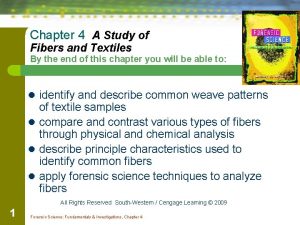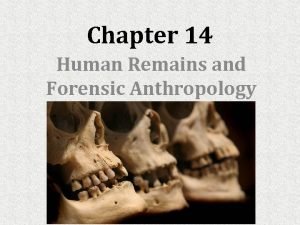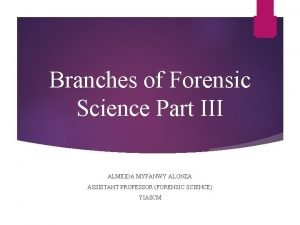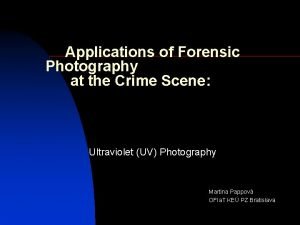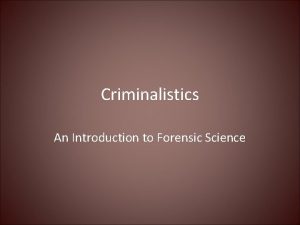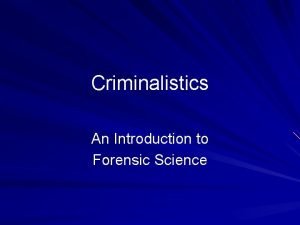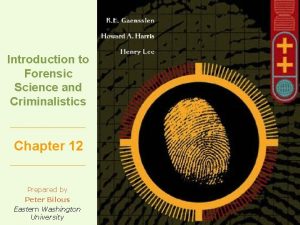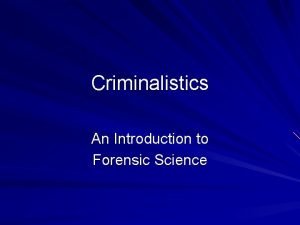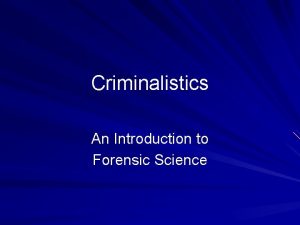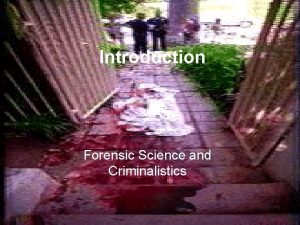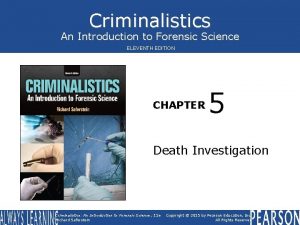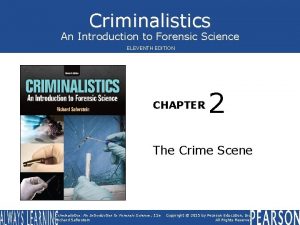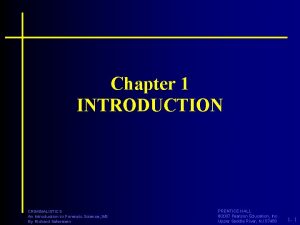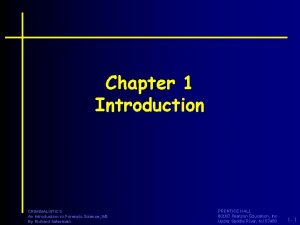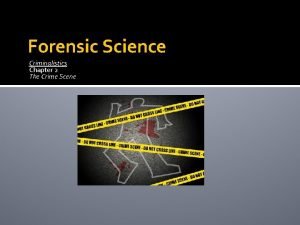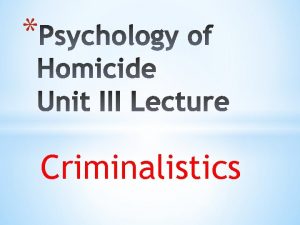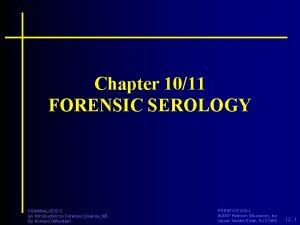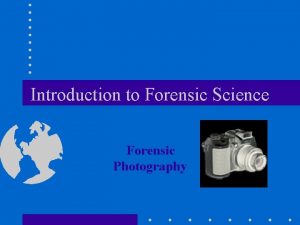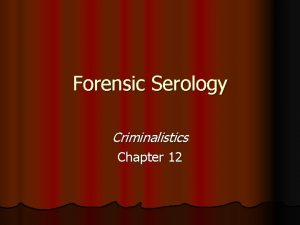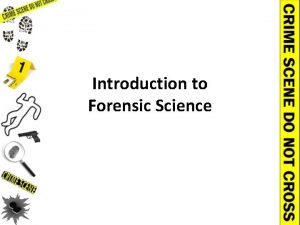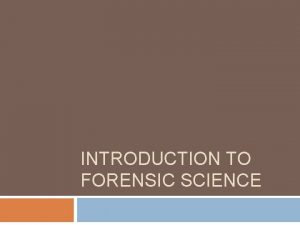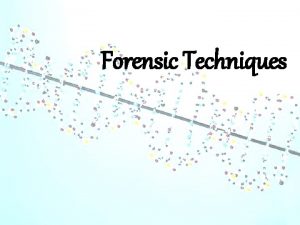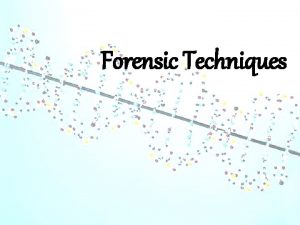An Introduction to forensic Science Forensic Science criminalistics




































- Slides: 36

An Introduction to forensic Science • Forensic Science (criminalistics) = The application of science (chemistry, biology, physics, geology) to those criminal and civil laws that are enforced by police agencies in a criminal justice system • Why is it called forensic science?

Do Now: There are many different types of scientists that work in criminal cases. Can you identify each scientist? A. Chemist B. Entomologist C. Geologist D. Meteorologist E. Radiologist F. Toxicologist • • • __ 1. Works with X-rays __ 2. Use insects to determine time of death __ 3. Examines soil samples __ 4. Work with climatic conditions __ 5. Analyzes paint, glass, and residues __ 6. Analyzes blood and body tissues for evidence of drugs and poisons

The answers are. . . A. Anthropologist B. Botanist C. Odontologist D. Pathologist E. Psychiatrist F. Serologist • D_1. Examines body tissues to determine cause of death • C_ 2. Analyzes dental records and dental work • B_ 3. Analyzes botanical (plant) evidence • A_ 4. Analyzes skeletal remains • E_5. Provides personality profiles based on evidence • F_ 6. Analyzes blood evidence

Your Task • While we are viewing the following slides, please make a list of all forensic disciplines mentioned with a short definition for each. • Through the lesson, we will enrich this list and use it to assign homework.

Toxicology • Forensic toxicology is the study of the effects of extraneous materials such as poisons and drugs in the body • Forensic toxicologists must determine both the presence and the amounts of extraneous materials in the body • For this purpose biological materials are subjected to a chemical study. Blood and urine are often examined for the presence of foreign substances, but tissues and hairs can also be examined. Mathieu J. B. Orfila: “father of forensic toxicology”. One of the most renowned medicolegalist of the time was Mathieu Orfila (1787 -1853) • Mathieu Orfila is best known for his involvement in the “Lafarge” arsenic poisoning case in France

Marie Lafarge (15 January 1816 - 7 • November 1852) was a French woman who was convicted of murdering her husband by arsenic poisoning in 1840. Her case became notable, because it was one of the first trials to be followed by the public through daily newspaper reports, and because she was the first person convicted largely on direct forensic toxicological evidence. . Toxicology = Study of poisons

Toxins in Hair • Hair is capable of recording medium to long-term or high dosage substance abuse. Chemicals in the bloodstream may be transferred to the growing hair and stored in the follicle, providing a rough timeline of drug intake events. • Head hair grows at rate of approximately 1 to 1. 5 cm a month, and so cross sections from different sections of the follicle can give estimates as to when a substance was ingested. • Testing for drugs in hair is not standard throughout the population. The darker and coarser the hair the more drug that will be found in the hair. If two people consumed the same amount of drugs, the person with the darker and coarser hair will have more drug in their hair than the lighter haired person when tested. This raises issues of possible racial bias in substance tests with hair samples.

Napoleon’s Case • • For decades, scholars and scientists have argued that the exiled dictator, who died in 1821 on the remote island of St. Helena in the South Atlantic, was the victim of arsenic, whether by accident or design. The evidence behind both theories was that scientists had found arsenic in hairs from Napoleon’s head, which diminished the idea that he had died of stomach cancer. Arsenic is highly toxic, and its poisoning symptoms include violent stomach pains. But now, a team of scientists at Italy’s National Institute of Nuclear Physics in Milan. Bicocca and Pavia has uncovered strong evidence to the contrary. They conducted a detailed analysis of hairs taken from Napoleon’s head at four times in his life — as a boy in Corsica, during his exile on the island of Elba, the day he died on St. Helena, at age 51, and the day afterward — and discovered that the arsenic levels underwent no significant rises. Casting a wide net, the scientists also studied hairs from his son, Napoleon II, and his wife, Empress Josephine. Here, too, they found that the arsenic levels were similar and uniformly high.

Forensic Pathology • Pathology is a specialty area of medicine • Pathology is the study of diseases and the bodily changes caused by the diseases • Forensic pathologists determine the cause of death (the medical reason why a person died; e. g. asphyxiation) • Forensic pathologists determine the manner of death (the circumstances causing death; e. g. homicide) • What is the difference between Cause and Manner of death?

Autopsy

Forensic Odontology • Forensic dentistry (odontology) is a vital branch of forensic science that involves the application of dental science to the identification of unknown human remains and bite marks, using both physical and biological dental evidence. • Forensic dentists deal with a range of medicolegal problems. Identification of the human remains of natural disasters, terrorist activities, and missing and unknown persons is a central activity

Odontology

Forensic Anthropology • The next time you read in the newspaper or hear on the radio or TV that a body or skeleton has been found, it is likely that a forensic anthropologist will be contacted to identify it. Forensic anthropologists are also called to identify individuals killed in disasters such as plane crashes, explosions, fires, and other tragedies resulting in the loss of life and mutilation of bodies. • Law enforcement agencies need to know if recovered bones are human or non-human. If they are human and of recent origin, the individual must be identified, and the cause of death and time elapsed since death need to be determined. If they are old, human bones, perhaps a burial ground has been uncovered.

Forensic anthropologists: – Can determine whether found remains are of human or animal origin – Reconstruct the skeleton from found remains – Provide an estimate of age, stature, and gender – Can sometimes determine racial origin – Detect skeletal abnormalities and any trauma – Can provide information about the cause of death

Forensic Anthropology.

Forensic Entomology – Entomology is a branch of biology devoted to the study of insects – Forensic entomologists use insects as investigative aids – By examining insects, larvae or pupae associated with a corpse, knowing the life cycle of insects, and by using the existing environmental factors, forensic entomologists can estimate the time of death. – What are some of the insects that are used in forensic entomologists? How do they use them?

Corpse fauna

Forensic Facial Reconstruction • An example of a 2 D facial reconstruction conducted by forensic artist Karen T. Taylor, and the subsequent identification • .

Forensic Sculptors Frank Bender, who died on July 28 2011 aged 70, was a forensic sculptor whose handmade busts helped police to identify victims of accidents and foul play and to solve some of America's most baffling homicides. John Emil List nearly got away with murder. For nearly 18 years after murdering his wife, mother and three children, List went on with his life in Denver, Colorado, until he was featured on America's Most Wanted in 1989.

John List (Family Annihilator) • Extremely religious man, believes wife and family on “wrong” path • November 1971, kills wife, mother and 3 kids, – – places bodies in sleeping bags, with cloths over faces mother killed in attic, cloth placed over face all are killed with gunshots bodies not found until December, List is missing • List leaves notes apologizing to other family members & boss – also funeral arrangements with pastor • Life history becomes clear – – wife is ill, and has grown to despise him mother is domineering children have come to dislike him financial problems, loss of job

List Part 2 • Discontinued newspaper, milk delivery to home • Killed wife and mother during breakfast while children at school – wife shot in jaw, mother above left eye • • rakes leaves picks teenage daughter up at school, shoots her in back of head picks up son from school, shoots him in head other son surprises him by coming home early – struggle ensues, son hit in eye – shot total of 10 times • Writes confession to pastor • Leaves for new life

List Part 3 • Changes name to Robert Clark, forms new life and remarries • Begins to have similar financial and family problems • Ends up on America’s Most Wanted (hosted by John Walsh) – neighbor phones police, but call is missed • FBI gets call, track List down, arrest him • April 12, 1990, guilty of murder, gets 5 consecutive life terms in prison • List died of pneumonia in prison on March 21, 2008 at the age of 82.

Forensic Psychiatry & Psychology • Forensic psychiatrists & psychologists evaluate offenders for civil and criminal competence and may be involved in offender treatment programs • A few specialize in “profiling” of criminal cases, primarily serial murderers and serial rapists.

The Criminal Mind “In this true Mirror we may plainly see what wretches people all by nature be. ” • . “The criminal personality profile is based on good crime scene examination and adequate information supplied to the profiler”

Profile of a Witch Used to identify witches in Europe from 1400’s to 1700’s: • • Elderly female beyond child bearing range Poor • Lives on edge of town • Displays knowledge of herbal medicines • Mark of the Devil (insensitive spot) • Steals men’s potency, causing impotence in the surrounding areas • Collects a great number of male members and keeps them in a birds nest or box • (Cyriax, 1993; Kramer & Sprenger, 1971; Ruiz, 2004).

Lombroso’s (1876) Profile of Murderers • • • Italian criminologist and doctor An aquiline (hook) or beak of a nose Fleshy swollen, and protruding lips Small receding chin Dark hair and bushy eyebrows that meet across the nose Little or no beard Displays an abundance of wrinkles, even in those younger than thirty 4 to 5 times greater taste sensibility than the average person A cynical attitude, completely lacking remorse More likely to bear a tattoo Attaches no importance to dress and are frequently dirty and shabby

First Profile? : ‘Jack the Ripper’ London 1888 • • • First known case of killer profiling-Dr. Thomas Bond examined the victim-Mary Kelly Often considered the first recorded serial killer because of the nature of the crimes (sexual motive, 5 -11 prostitutes, throats slashed, genital area mutilated, facial area mutilated, 3 eviscerations with organ removal). In Bond’s opinion the killer must have been a man of solitary habits, subject to "periodical attacks of homicidal and erotic mania", with the character of the mutilations possibly indicating hyper sexuality. While there is no evidence of any sexual activity with any of the victims, some psychologists suppose that the penetration of the victims with a knife and "leaving them on display in sexually degrading positions with the wounds exposed" indicates that the perpetrator derived sexual pleasure from the attacks. The Ripper was never apprehended.

First documented case • New York City 1950’s • “Mad Bomber”-George P. Metesky-terrorized New York City for 16 years in the 1940 s and 1950 s with explosives that he planted in theaters, terminals, libraries and offices. Bombs were left in phone booths, storage lockers and restrooms in public buildings, including Grand Central Terminal, Pennsylvania Station, Radio City Music Hall, the New York Public Library, the Port Authority Bus Terminal and the RCA Building, as well as in the New York City Subway. • Psychiatrist James Brussell constructs a profile: – White male, 40’s - 50’s, Eastern European – Lives with aunt or sister – Hates father, loves mother – Will wear double-breasted suit when apprehended

Example of Profiling and the BTK killer • Serial killer in Kansas active from 1974 to 2005 • Murdered 10 people from 1974 – 1991 (caught in 2005) • Variety of profiles based on crime scene analysis were summarised as: • • • “Look for an American male with a possible connection to the military. His IQ will be above 105. He will like to masturbate, and will be aloof and selfish in bed. He will drive a decent car. He will be a ‘now’ person. He won’t be comfortable with women. But he may have women friends. He will be a lone wolf. But he will be able to function in social settings…he will be either, never married, divorced or married, and if he is married his wife will be younger or older. He may or may not live in a rental, and might be lower class, upper lower class, lower middle class or middle class. And he will be crazy like a fox, as opposed to being mental. ” Gladwell (2007)

“Father of profiling” John Douglas – 25 years with the FBI, Investigative Support Unit – Developed profiling techniques now taught in the FBI’s Behavioral Science Unit – Consulted on Atlanta child murders, Green River killer, Unabomber

Dactyloscopy: the study of fingerprints • Skin has an outer layer (epidermis) which has ridges projecting inward, and an inner layer (dermis) which has projections pressing into the spaces between ridges • A fingerprint is a pattern made by the friction ridges, which is left behind due to sweat and oil that sticks to them. • A fingerprint is an individual characteristic. • A fingerprint will remain unchanged during an individual’s lifetime. • Fingerprints have general characteristics ridge patterns that permit them to be systematically classified

Alphonse Bertillon: Anthropometry • Developed an anthropometric system for human identification in the 1890 s • Anthropometry = The study of human body measurement for use in anthropological classification and comparison • Do you see a problem with that? Explain

Alphonse Bertillon Limitations • The limitations of this system was shown by its inability to distinguish between two Leavenworth, Kansas, penitentiary prisoners, Will West & William West • The Bertillon system was eventually replaced by the fingerprint system being developed by Francis Galton, William Hershel, Edward Henry & others in the late 1800 s

Will west and William West • • • They looked identical and even shared the same name, but the two prisoners pictured were actually different people and their remarkable case helped bring in the era of fingerprint identification. The man above was called Will West, the man below William West, and they were both sentenced to jail at Leavenworth Penitentiary in Kansas over 100 years ago. The arrival of Will West in 1903 caused the records clerk at the prison considerable confusion, because he was convinced he'd processed him two years previously. The clerk set about taking his Bertillon measurements. He looked up his name in his filing system and found one William West – who To the clerk’s shock, he was absolutely right. looked identical to Will West in the photographs William West was a different person altogether in every respect. They even shared the same and in fact had been admitted to the prison two years previously for murder. Bertillon measurements. America’s first national fingerprint repository was Will West insisted that it was not him: ‘That’s established shortly afterwards. What makes this system far superior to the my picture, but I don’t know where you got it, Bertillion system? for I know I have never been here before. ’

Fingerprint (minutia) details are unique: even identical twins have unique fingerprints • Fingerprinting has served all governments worldwide during the past 100 years or so to provide accurate identification of criminals. • No two fingerprints have ever been found identical in many billions of human and automated computer comparisons. • It remains the most commonly gathered forensic evidence worldwide and in most jurisdictions fingerprint examination outnumbers all other forensic examination casework combined. • Moreover, it continues to expand as the premier method for identifying persons, with tens of thousands of people added to fingerprint repositories daily in America alone — far more than other forensic databases. There is more than 450 million fingerprints in the FBI master database of criminal files. http: //wiki. answers. com/Q/How_many_fingerprints_are_in_th e_FBI_master_databaseof_criminal_files#ixzz 264 s. OBZv. M

Development of Forensic Science Laboratories Edmond Locard: Father of Forensic Science • Established one of the world’s first police crime laboratories in Lyon, France in 1910. • He is known for the Locard Exchange • Principle, which states that “once contact is • made between two surfaces, a transfer of • Materials occurs”.
 Forensic criminalist
Forensic criminalist American board of criminalistics
American board of criminalistics Forensic science powerpoint
Forensic science powerpoint Forensic science unit 1 review
Forensic science unit 1 review Forensic science an introduction
Forensic science an introduction Forensic science chapter 1
Forensic science chapter 1 Forensic anthropologist vs forensic pathologist
Forensic anthropologist vs forensic pathologist Who is this
Who is this Sciencefusion think central
Sciencefusion think central My favourite subject is english because
My favourite subject is english because Introduction to forensic psychology bartol pdf
Introduction to forensic psychology bartol pdf Introduction to forensic medicine
Introduction to forensic medicine Journal of forensic and investigative accounting
Journal of forensic and investigative accounting Terminal ballistics forensics
Terminal ballistics forensics Introduction to forensic accounting
Introduction to forensic accounting Sola pith aptae viris
Sola pith aptae viris Pigment granules in hair
Pigment granules in hair Mass spectrometry in forensic science
Mass spectrometry in forensic science Who established the first workable crime laboratory?
Who established the first workable crime laboratory? Different types of serial killers
Different types of serial killers Leone lattes contribution to forensic science
Leone lattes contribution to forensic science Forensic tire tread evidence worksheet
Forensic tire tread evidence worksheet Cins ve tür arasındaki fark
Cins ve tür arasındaki fark Forensic science foodborne outbreak investigation answers
Forensic science foodborne outbreak investigation answers What is forensic science
What is forensic science Forensic science begins at the crime scene
Forensic science begins at the crime scene Forensic science arson activity
Forensic science arson activity The golden book of camping
The golden book of camping Hair and fiber evidence worksheet answers
Hair and fiber evidence worksheet answers What is an observation in forensic science
What is an observation in forensic science Chapter 4 notes fiber evidence
Chapter 4 notes fiber evidence Nibis definition forensics
Nibis definition forensics Chapter 14 review forensic science
Chapter 14 review forensic science Branches of forensic science
Branches of forensic science Forensic photography management
Forensic photography management Willingham fire
Willingham fire Department of forensic science dc
Department of forensic science dc
